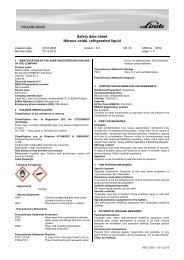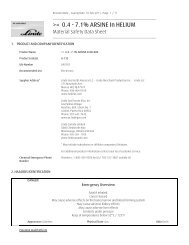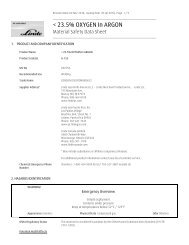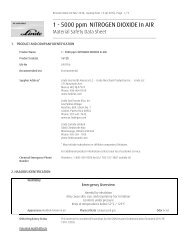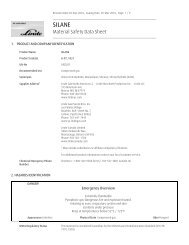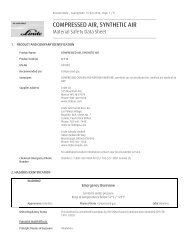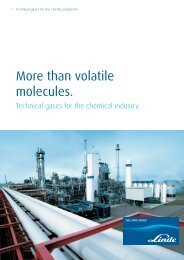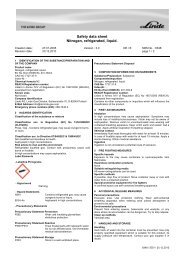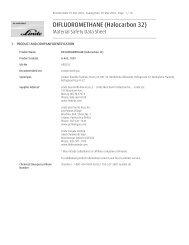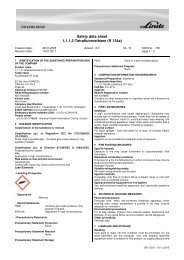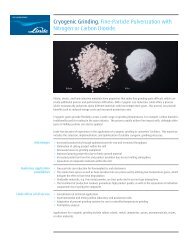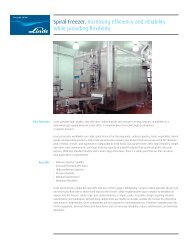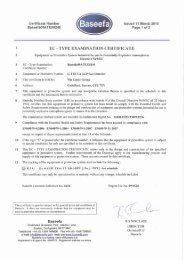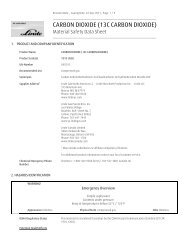CHLORODIFLUOROMETHANE (Halocarbon R22) - (MSDS) - Linde ...
CHLORODIFLUOROMETHANE (Halocarbon R22) - (MSDS) - Linde ...
CHLORODIFLUOROMETHANE (Halocarbon R22) - (MSDS) - Linde ...
You also want an ePaper? Increase the reach of your titles
YUMPU automatically turns print PDFs into web optimized ePapers that Google loves.
Revision Date 25-Aug-2010, Issuing Date 05-Mar-2010, Page 1 / 9_____________________________________________________________________<strong>CHLORODIFLUOROMETHANE</strong> (<strong>Halocarbon</strong> <strong>R22</strong>)Material Safety Data Sheet_____________________________________________________________________1. PRODUCT AND COMPANY IDENTIFICATIONProduct Name <strong>CHLORODIFLUOROMETHANE</strong> (<strong>Halocarbon</strong> <strong>R22</strong>)Product Code(s) G-46UN-NoRecommended UseSynonymsSupplier Address*UN1018Refrigerant.Chlorofluoromethane; Difluoromonochloromethane; Monochlorodifluoromethane; FC-22; HCFC-22<strong>Linde</strong> Gas North America LLC - <strong>Linde</strong> Merchant Production Inc. - <strong>Linde</strong> LLC575 Mountain Ave.Murray Hill, NJ 07974Phone: 908-464-8100www.lindeus.com<strong>Linde</strong> Gas Puerto Rico, Inc.Las Palmas VillageRoad No. 869, Street No. 7Catano, Puerto Rico 00962Phone: 787-641-7445www.pr.lindegas.com<strong>Linde</strong> Canada Limited5860 Chedworth WayMississauga, Ontario L5R 0A2Phone: 905-501-1700www.lindecanada.com* May include subsidiaries or affiliate companies/divisions.For additional product information contact your local customer service.Chemical Emergency PhoneNumberChemtrec: 1-800-424-9300 for US/ 703-527-3887 outside US2. HAZARDS IDENTIFICATIONWARNING!Emergency OverviewAsphyxiant at high concentrationsContact with liquid may cause frostbite.Contents under pressureMay cause central nervous system depressionCauses adverse cardiovascular effectsKeep at temperatures below 52°C / 125°FAppearance Colorless Physical State Compressed gas. Odor Slight ethereal
<strong>CHLORODIFLUOROMETHANE</strong> (<strong>Halocarbon</strong> <strong>R22</strong>), Material Safety Data Sheet , Revision Date 25-Aug-2010,Page 2 / 9___________________________________________________________________OSHA Regulatory Status This material is considered hazardous by the OSHA Hazard Communication Standard (29 CFR1910.1200).Potential Health EffectsPrinciple Routes of ExposureInhalation. Skin contact.Acute ToxicityInhalationEyesSkinSkin Absorption HazardIngestionChronic EffectsAggravated MedicalConditionsInteractions with Other ChemicalsEnvironmental HazardHigh concentrations may cause asphyxia from lack of oxygen or act as a narcotic causing centralnervous system depression. Symptoms of overexposure are dizziness, headache, tiredness, nausea,unconsciousness, cessation of breathing. Oxygen deficiency may occur in the presence of highconcentrations resulting in asphyxiation. Maintain oxygen levels at or above 19.5%.This product is a gas at room temperature. Contact with liquid may cause frostbite.This product is a gas at room temperature. Contact with liquid may cause frostbite.No known hazard in contact with skin.Not an expected route of exposure.Possible risks of irreversible effects.Central nervous system. Cardiovascular. Heart.Use of alcoholic beverages may enhance toxic effects.See Section 12 for additional Ecological Information.3. COMPOSITION/INFORMATION ON INGREDIENTSChemical Name CAS-No Volume % Chemical FormulaChlorodifluoromethane 75-45-6 >99 CHF2Cl4. FIRST AID MEASURESGeneral AdviceEye ContactSkin ContactInhalationIngestionImmediate medical attention is required. Show this safety data sheet to the doctor in attendance.None required for gas. If frostbite is suspected, flush eyes with cool water for 15 minutes and obtainimmediate medical attention.None required for gas. For dermal contact or suspected frostbite, remove contaminated clothing andflush affected areas with lukewarm water. DO NOT USE HOT WATER. A physican should see the patientpromptly if contact with the product has resulted in blistering of the dermal surface or in deep tissuefreezing.PROMPT MEDICAL ATTENTION IS MANDATORY IN ALL CASES OF INHALATION OVEREXPOSURE. RESCUEPERSONNEL SHOULD BE EQUIPPED WITH SELF-CONTAINED BREATHING APPARATUS. Conscious inhalationvictims should be assisted to an uncontaminated area and inhale fresh air. If breathing is difficult,administer oxygen. Unconscious persons should be moved to an uncontaminated area and, asnecessary, given artificial resuscitation and supplemental oxygen. Treatment should be symptomaticand supportive.None under normal use. Get medical attention immediately if symptoms occur.
<strong>CHLORODIFLUOROMETHANE</strong> (<strong>Halocarbon</strong> <strong>R22</strong>), Material Safety Data Sheet , Revision Date 25-Aug-2010,Page 3 / 9___________________________________________________________________Notes to Physician A patient adversely affected by exposure to this product should not be given adrenaline (epinephrine)or similar heart stimulant since these would increase the risk of cardiac arrhythmias.5. FIRE-FIGHTING MEASURESFlammable PropertiesSuitable Extinguishing MediaHazardous Combustion ProductsNot flammable.Use extinguishing measures that are appropriate to local circumstances and the surroundingenvironment.Hydrogen fluoride. Carbonyl fluoride. Phosgene. Hydrogen chloride.Explosion DataSensitivity to Mechanical ImpactSensitivity to Static DischargeSpecific Hazards Arising from theChemicalProtective Equipment andPrecautions for FirefightersNoneNoneCylinders may rupture under extreme heat. Continue to cool fire exposed cylinders until flames areextinguished. Damaged cylinders should be handled only by specialists.As in any fire, wear self-contained breathing apparatus pressure-demand, MSHA/NIOSH (approved orequivalent) and full protective gear.6. ACCIDENTAL RELEASE MEASURESPersonal PrecautionsEnvironmental PrecautionsMethods for ContainmentMethods for Cleaning UpEnsure adequate ventilation. Evacuate personnel to safe areas. Use personal protective equipment.Monitor oxygen level.Prevent spreading of vapors through sewers, ventilation systems and confined areas.Stop the flow of gas or remove cylinder to outdoor location if this can be done without risk. If leak is incontainer or container valve, contact the appropriate emergency telephone number in Section 1 or callyour closest <strong>Linde</strong> location.Return cylinder to <strong>Linde</strong> or an authorized distributor.7. HANDLING AND STORAGEHandlingUse only in ventilated areas. Never attempt to lift a cylinder by its valve protection cap.
<strong>CHLORODIFLUOROMETHANE</strong> (<strong>Halocarbon</strong> <strong>R22</strong>), Material Safety Data Sheet , Revision Date 25-Aug-2010,Page 4 / 9___________________________________________________________________Protect cylinders from physical damage; do not drag, roll, slide or drop. When moving cylinders, evenfor short distance, use a cart designed to transport cylinders. Use equipment rated for cylinderpressure. Use backflow preventive device in piping. Never insert an object (e.g. wrench, screwdriver,pry bar,etc.) into valve cap openings. Doing so may damage valve, causing leak to occur.Use an adjustable strap wrench to remove over-tight or rusted caps. Close valve after each use andwhen empty. If user experiences any difficulty operating cylinder valve discontinue use and contactsupplier.Never put cylinders into trunks of cars or unventilated areas of passenger vehicles. Never attempt torefill a compressed gas cylinder without the owner's written consent. Never strike an arc on acompressed gas cylinder or make a cylinder a part of an electrical circuit.For additional recommendations consult Compressed Gas Association's (CGA) Safety Bulletin SB-2,Oxygen-Deficient Atmospheres.StorageProtect from physical damage. Cylinders should be stored upright with valve protection cap in placeand firmly secured to prevent falling. Store in cool, dry, well-ventilated area of non-combustibleconstruction away from heavily trafficked areas and emergency exits. Keep at temperatures below52°C / 125°F. Full and empty cylinders should be segregrated. Use a "first in-first out" inventorysystem to prevent full cylinders from being stored for excessive periods of time. Always store andhandle compressed gas cylinders in accordance with Compressed Gas Association, pamphlet CGA-P1,Safe Handling of Compressed Gases in Containers.8. EXPOSURE CONTROLS / PERSONAL PROTECTIONExposure GuidelinesChemical Name ACGIH TLV OSHA PEL NIOSH IDLHChlorodifluoromethane75-45-6TWA: 1000 ppm(vacated) TWA: 1000 ppm(vacated) TWA: 3500 mg/m 3TWA: 1000 ppmTWA: 3500 mg/m 3STEL: 4375 mg/m 3STEL: 1250 ppmNIOSH IDLH: Immediately Dangerous to Life or Health.Other Exposure GuidelinesEngineering MeasuresVentilationVacated limits revoked by the Court of Appeals decision in AFL-CIO v. OSHA, 965 F.2d 962 (11th Cir.,1992).Showers. Eyewash stations. Ventilation systems. Local exhaust ventilation to prevent accumulation ofhigh concentrations and maintain air-oxygen levels at or above 19.5%.Ensure adequate ventilation, especially in confined areas.Personal Protective EquipmentEye/Face ProtectionSkin and Body ProtectionWear protective eyewear (safety glasses). If splashes are likely to occur, wear: Goggles. Face-shield.Wear cold insulating gloves when handling liquid. Work gloves and safety shoes are recommendedwhen handling cylinders.Respiratory ProtectionGeneral UseEmergency UseHygiene MeasuresNo special protective equipment required.Use positive pressure airline respirator with escape cylinder or self contained breathing apparatus foroxygen-deficient atmospheres (
<strong>CHLORODIFLUOROMETHANE</strong> (<strong>Halocarbon</strong> <strong>R22</strong>), Material Safety Data Sheet , Revision Date 25-Aug-2010,Page 5 / 9___________________________________________________________________9. PHYSICAL AND CHEMICAL PROPERTIESAppearanceColorless.OdorSlight ethereal.Odor ThresholdNo information available.Physical StateCompressed gasFlash PointNo information available.Autoignition Temperature No information available.Decomposition Temperature No information available.Boiling Point/Range-40.8°C / -41.4°FFreezing Point -160°C / -256°F Molecular Weight 86.47Water SolubilitySlightly solubleEvaporation RateNo information availableVapor Pressure 136 PSIA @ 70°F Vapor Density 3.06 (air = 1)VOC Content (%)Not applicable.Flammability Limits in AirUpperNot applicableLowerNot applicable10. STABILITY AND REACTIVITYStabilityIncompatible ProductsConditions to AvoidHazardous DecompositionProductsHazardous PolymerizationStable.May react violently with chemically active metals such as sodium, potassium and barium, powderedmagnesium, powdered aluminum and organometallics.Heat, flames and sparks.Hydrogen fluoride. Carbonyl fluoride. Hydrogen bromide.Hazardous polymerization does not occur.11. TOXICOLOGICAL INFORMATIONAcute ToxicityLD50 Oral:LD50 Dermal:LC50 Inhalation:InhalationEye ContactSkin ContactRepeated Dose ToxicityNo information available.No information available.No information available.High concentrations may cause ventricular fibrillation and CNS effects.May cause slight irritation.May cause irritation.No information available.Chronic ToxicityChronic ToxicityCarcinogenicityPossible risks of irreversible effects.Contains no ingredient listed as a carcinogen.
<strong>CHLORODIFLUOROMETHANE</strong> (<strong>Halocarbon</strong> <strong>R22</strong>), Material Safety Data Sheet , Revision Date 25-Aug-2010,Page 6 / 9___________________________________________________________________Chemical Name ACGIH IARC NTP OSHAChlorodifluoromethane Group 3IrritationSensitizationMutagenic EffectsReproductive ToxicityDevelopmental ToxicitySynergistic MaterialsTarget Organ EffectsNo information available.No information available.Mutations were produced in a bacterial (S. typhimurim) assay system at 330,000 ppm.Exposure to male rats to 50,000 ppm for 5 hours adversely effected the reproductive system.Oxygen deficiency during pregnancy has produced developmental abnormalities in humans andexperimental animals.None known.Central nervous system (CNS). Heart.12. ECOLOGICAL INFORMATIONEcotoxicityProduct is known to contribute to the destruction of the ozone layer.Ozone depletion potential; ODP; (R-11 = 1): 0.055 ODP; Class II.Chemical NameLog PowChlorodifluoromethane 1.0813. DISPOSAL CONSIDERATIONSWaste Disposal MethodsDo not attempt to dispose of residual waste or unused quantities. Return in the shipping containerPROPERLY LABELED WITH ANY VALVE OUTLET PLUGS OR CAPS SECURED AND VALVE PROTECTION CAP INPLACE to <strong>Linde</strong> for proper disposal.14. TRANSPORT INFORMATIONDOTProper Shipping NameChlorodifluoromethaneHazard Class 2.2UN-NoUN1018Description UN1018, Chlorodifluoromethane, 2.2Emergency Response Guide Number 126TDGProper Shipping NameChlorodifluoromethaneHazard Class 2.2UN-NoUN1018Description UN1018, <strong>CHLORODIFLUOROMETHANE</strong>, 2.2
<strong>CHLORODIFLUOROMETHANE</strong> (<strong>Halocarbon</strong> <strong>R22</strong>), Material Safety Data Sheet , Revision Date 25-Aug-2010,Page 7 / 9___________________________________________________________________MEXProper Shipping NameChlorodifluoromethaneHazard Class 2.2UN-NoUN1018Description UN1018, Chlorodifluoromethane, 2.2IATAUN-NoUN1018Proper Shipping NameChlorodifluoromethaneHazard Class 2.2ERG Code2LDescription UN1018, Chlorodifluoromethane, 2.2Maximum Quantity for Passenger75 kgMaximum Quantity for Cargo Only150 kgLimited QuantityNo information available.IMDG/IMOProper Shipping NameChlorodifluoromethaneHazard Class 2.2UN-NoUN1018EmS No.F-C, S-VDescription UN1018, Chlorodifluoromethane, 2.2ADRProper Shipping Name Chlorodifluoromethane (Refrigerant gas R 22)Hazard Class 2.2UN-NoUN1018Classification Code2ADescription UN1018, Chlorodifluoromethane (Refrigerant gas R 22), 2.215. REGULATORY INFORMATIONInternational InventoriesTSCADSLEINECS/ELINCSCompliesCompliesCompliesLegendTSCA - United States Toxic Substances Control Act Section 8(b) InventoryDSL/NDSL - Canadian Domestic Substances List/Non-Domestic Substances ListEINECS/ELINCS - European Inventory of Existing Commercial Chemical Substances/EU List of Notified Chemical SubstancesU.S. Federal RegulationsSARA 313Section 313 of Title III of the Superfund Amendments and Reauthorization Act of 1986 (SARA). This product contains a chemical or chemicalswhich are subject to the reporting requirements of the Act and Title 40 of the Code of Federal Regulations, Part 372:
<strong>CHLORODIFLUOROMETHANE</strong> (<strong>Halocarbon</strong> <strong>R22</strong>), Material Safety Data Sheet , Revision Date 25-Aug-2010,Page 9 / 9___________________________________________________________________This product has been classified in accordance with the hazard criteria of the Controlled Products Regulations (CPR) and the <strong>MSDS</strong>contains all the information required by the CPR.WHMIS Hazard ClassA Compressed gasesChemical NameChlorodifluoromethaneNPRIXLegendNPRI - National Pollutant Release Inventory16. OTHER INFORMATIONPrepared ByIssuing DateRevision DateProduct Stewardship23 British American Blvd.Latham, NY 121101-800-572-650105-Mar-201025-Aug-2010Revision Number 1Revision Note (M)SDS sections updated. 1.NFPA Health Hazard 2Flammability 0Stability 1Physical and ChemicalHazards -HMIS Health Hazard 1 Flammability 0 Physical Hazard 2 Personal Protection -Note: Ratings were assigned in accordance with Compressed Gas Association (CGA) guidelines as published in CGA Pamphlet P-19-2009,CGA Recommended Hazard Ratings for Compressed Gases, 3rd Edition.General DisclaimerFor terms and conditions, including limitation of liability, please refer to the purchase agreement in effect between <strong>Linde</strong> LLC, <strong>Linde</strong> MerchantProduction, Inc. or <strong>Linde</strong> Gas North America LLC (or any of their affiliates and subsidiaries) and the purchaser.DISCLAIMER OF EXPRESSED AND IMPLIED WARRANTIESAlthough reasonable care has been taken in the preparation of this document, we extend no warranties and make no representations as to the accuracyor completeness of the information contained herein, and assume no responsibility regarding the suitability of this information for the user's intendedpurposes or for the consequences of its use. Each individual should make a determination as to the suitability of the information for their particularpurpose(s).End of Safety Data Sheet



